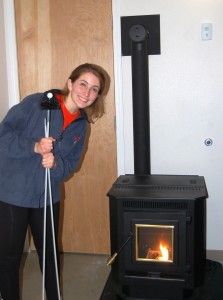Pellets are a biomass fuel that is used in pellet stoves and boilers. Unlike the cordwood burned by woodstoves, pellets are a manufactured fuel source that consists of biomass byproducts such as sawdust, wood chips, waste paper and agricultural waste. Pellet ingredients are bound together by pressure and heat instead of glue, as in a manufacturing plant, then sold in 40-pound bags at local hardware stores or by the ton from a manufacturer.
There are several places in Fairbanks to purchase pellets by the bag. Two types of pellets are manufactured in Oregon by West Oregon Wood Products and are made predominantly from Douglas Fir, a tree found in the Pacific Northwest. The other type is made locally at Superior Pellet Fuels in North Pole, consisting of approximately 90 percent spruce gathered from local businesses, including Windstorm Salvage Timber Sales and Northland Wood Sawmills. The remaining 10 percent consists of cottonwood and aspen sawdust and scraps from timber harvests in the Interior.
All pellets are refined by manufacturers to be uniform in size, density, moisture and energy content. However, pellets made by different manufacturers will have different characteristics because of the variety in raw materials and manufacturing processes. For consumers to compare the basic characteristics of pellets from different sources, the Pellet Fuels Institute (www.pelletheat.org) has developed standards for pellet fuels sold in the United States. Manufacturers send their pellets to a third-party lab for testing and pellets are classified into three categories, depending on the standards that the pellets consistently meet.
PFI Utility Pellets
• bulk density of 38-46 lbs. per cubic foot
• ash content 6 percent or below
• moisture content
10 percent or below
PFI Standard Pellets
• bulk density of 38-46 lbs. per cubic foot
• ash content 2 percent or below
• moisture content
10 percent or below
PFI Premium Pellets
• bulk density of 40-46 lbs. per cubic foot
• ash content 1 percent or below
• moisture content
8 percent or below
Both types of pellets available in Fairbanks exceed the PFI Premium Standard. The West Oregon Wood Products lists the specifications for its pellets on its website (www.wowpellets.com/fuel-pellets/wood-fuel-pellets/91-fuel-pellet-specs). They have a density of around 42 pounds per cubic foot, an ash content of 0.3 percent and a moisture content of 6 percent. Superior Pellets also made a testing report available for this article — they send sample pellets from the manufacturing plant each week to Twin Ports Testing in Wisconsin to ensure they continually meet Premium standards. Superior’s pellets have a bulk density of approximately 44 pounds per cubic foot, moisture content of 6.5 percent, and 0.5 percent ash content.
When purchasing pellets, homeowners should consider bags that meet PFI Premium standards as these pellets have a higher Btu content because of their low moisture and higher density. For pellets not labeled as meeting the standard, consumers should research the moisture content, bulk density and ash content when deciding which brand to purchase.
